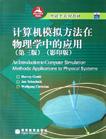计算机模拟方法在物理学中的应用
2006-09-01
高等教育出版社
Harvey Gould
796
无
《计算机模拟方法在物理学中的应用》(第3版影印版)是在美国大学使用很广泛的一本经典的,讲解如何使用计算机进行物理学数字模拟的教材,该书为刚刚出版的第三版。该书不是简单的物理学研究中的数学方法的介绍,而更注重在使用计算机模拟物理学问题中帮助学生更深刻的理解物理学,帮助学生在学习中了解和掌握使用计算机做物理学研究的一些基本手段,并学会如何根据具体的物理问题选择相应的研究方法。此外,还通过对具体的例子的讲解也为学习物理学的学生介绍了物理学广阔的应用天地。
作者:(美)古德
~~~ Introduction 1.1 Importance of Computers in Physics 1.2 The Importance of Computer Simulation 1.3 Programming Languages 1.4 Object-Oriented Techniques 1.5 How to Use this Book Appendix 1A: Laboratory Reports2 ~~ Tools for Doing Simulations 2. l Introduction 2.2 Simulating Free Fall 2.3 Getting Started with Object-Oriented Programming 2.4 Inheritance 2.5 The Open Source Physics Library 2.6 Animation and Simulation 2.7 Model-View-Controller Appendix 2A: Complex Numbers3 ~~ Simulating Particle Motion 3.1 Modified Euler Algorithms 3.2 Interfaces 3.3 Drawing 3.4 Specifying the State of a System Using Arrays 3.5 The ODE Interface 3.6 The ODESolver Interface 3.7 Effects of Drag Resistance 3.8 Two-Dimensional Trajectories 3.9 Decay Processes *3.10 Visualizing Three-Dimensional Motion 3.11 Levels of Simulation Appendix 3A: Numerical Integration of Newton's Equation of Motion4 ~~ Oscillatory Systems 4.1 Simple Harmonic Motion 4.2 The Motion of a Pendulum 4.3 Damped Harmonic Oscillator 4.4 Response to External Forces 4.5 Electrical Circuit Oscillations 4.6 Accuracy and Stability 4.7 Projects5 ~~ Few-Body Problems: The Motion of the Planets 5. l Planetary Motion 5.2 The Equations of Motion 5.3 Circular and Elliptical Orbits 5.4 Astronomical Units 5.5 Log-Log and Semilog Plots 5.6 Simulation of the Orbit 5.7 Impulsive Forces 5.8 Velocity Space 5.9 AMini-Solar System 5.10 Two-Body Scattering 5.11 Three-Body Problems 5.12 Projects6 ~~ The Chaotic Motion of Dynamical Systems 6.1 Introduction 6.2 ASimple One-Dimensional Map 6.3 Period Doubling 6.4 Universal Properties and Self-Similarity 6.5 Measuring Chaos *6.6 Controlling Chaos 6.7 Higher-Dimensional Models 6.8 Forced Damped Pendulum *6.9 Hamiltonian Chaos 6.10 Perspective 6.11 Projects Appendix 6A: Stability of the Fixed Points of the Logistic Map Appendix 6B: Finding the Roots of a Function7 ~~ Random Processes 7.1 Order to Disorder 7.2 Random Walks 7.3 Modified Random Walks 7.4 The Poisson Distribution and Nuclear Decay 7.5 Problems in Probability 7.6 Method of Least Squares 7.7 Applications to Polymers 7.8 Diffusion-Controlled Chemical Reactions 7.9 Random Number Sequences 7.10 Variational Methods 7.11 Projects Appendix 7A: Random Walks and the Diffusion Equation8 ~~ The Dynamics of Many-Particle Systems 8.1 Introduction 8.2 The Interrnolecular Potential 8.3 Units 8.4 The Numerical Algorithm 8.5 Periodic Boundary Conditions 8.6 A Molecular Dynamics Program 8.7 Thermodynamic Quantities 8.8 Radial Distribution Function 8.9 Hard Disks 8.10 Dynamical Properties 8.11 Extensions 8.12 Projects Appendix 8A: Reading and Saving Configurations9 ~~ Normal Modes and Waves 9.1 Coupled Oscillators and Normal Modes 9.2 Numerical Solutions 9.3 Fourier Series 9.4 Two-Dimensional Fourier Series 9.5 Fourier Integrals 9.6 Power Spectrum 9.7 Wave Motion 9.8 Interference 9.9 Fraunhofer Diffraction 9.10 Fresnel Diffraction Appendix 9A: Complex Fourier Series Appendix 9B: Fast Fourier Transform Appendix 9C: Plotting Scalar Fields10 ~~ Electrodynamics 10.1 Static Charges 10.2 Electric Fields 10.3 Electric Field Lines 10.4 Electric Potential 10.5 Numerical Solutions of Boundary Value Problems 10.6 Random Walk Solution of Laplace's Equation "10.7 Fields Due to Moving Charges "10.8 Maxwell's Equations 10.9 Projects 407 Appendix 10A: Plotting Vector Fields11 ~~ Numerical and Monte Carlo Methods 11.1 Numerical Integration Methods in One Dimension 11.2 Simple Monte Carlo Evaluation of Integrals 11.3 Multidimensional Integrals 11.4 Monte Carlo Error Analysis 11.5 Nonuniform Probability Distributions 11.6 Importance Sampling 11.7 Metropolis Algorithm * 11.8 Neutron Transport Appendix 11A: Error Estimates for Numerical Integration Appendix 11B: The Standard Deviation of the Mean Appendix 11C: The Acceptance-Rejection Method Appendix llD: Polynomials and Interpolation12 ~~ Percolation 12.1 Introduction 12.2 The Percolation Threshold 12.3 Finding Clusters 12.4 Critical Exponents and Finite Size Scaling 12.5 The Renormalization Group 12.6 Projects13 ~~ Fractals and Kinetic Growth Models 13.1 The Fractal Dimension 13.2 Regular Fractals 13.3 Kinetic Growth Processes 13.4 Fractals and Chaos 13.5 Many Dimensions 13.6 Projects 14 ~~ Complex Systems 14.1 Cellular Automata 14.2 Self-Organized Critical Phenomena 14.3 The Hopfield Model and Neural Networks 14.4 Growing Networks 14.5 Genetic Algorithms 14.6 Lattice Gas Models of Fluid Flow 14.7 Overview and Projects15 ~~ Monte Carlo Simulations of Thermal Systems 15.1 Introduction 15.2 The Microcanonical Ensemble 15.3 The Demon Algorithm 15.4 The Demon as a Thermometer 15.5 The Ising Model 15.6 The Metropolis Algorithm 15.7 Simulation of the Ising Model 15.8 The Ising Phase Transition 15.9 Other Applications of the Ising Model 15.10 Simulation of Classical Fluids 15.11 Optimized Monte Carlo Data Analysis * 15.12 Other Ensembles 15.13 More Applications 15.14 Projects Appendix 15A: Relation of the Mean Demon Energy to the Temperature Appendix 15B: Fluctuations in the Canonical Ensemble Appendix 15C: Exact Enumeration of the 2 x 2 Ising Model16 ~~ Quantum Systems 16.1 Introduction 16.2 Review of Quantum Theory 16.3 Bound State Solutions 16.4 Time Development of Eigenstate Superpositions 16.5 The Time-Dependent Schrrdinger Equation 16.6 Fourier Transformations and Momentum Space 16.7 Variational Methods 16.8 Random Walk Solutions of the Schrrdinger Equation 16.9 Diffusion Quantum Monte Carlo 16.10 Path Integral Quantum Monte Carlo 16.11 Projects Appendix 16A: Visualizing Complex Functions17 ~~ Visualization and Rigid Body Dynamics 17.1 Two-Dimensional Transformations 17.2 Three-Dimensional Transformations 17.3 The Three-Dimensional Open Source Physics Library 17.4 Dynamics of a Rigid Body 17.5 Quaternion Arithmetic 17.6 Quaternion Equations of Motion 17.7 Rigid Body Model 17.8 Motion of a Spinning Top 17.9 Projects Appendix 17A: Matrix Transformations Appendix 17B: Conversions18 ~~ Seeing in Special and General Relativity t8.1 Special Relativity 18.2 General Relativity 18.3 Dynamics in Polar Coordinates 18.4 Black Holes and Schwarzschild Coordinates 18.5 Particle and Light Trajectories 18.6 Seeing 18.7 General Relativistic Dynamics * 18.8 The Kerr Metric 18.9 Projects19 ~~ Epilogue: The Unity of Physics 19.1 The Unity of Physics 19.2 Spiral Galaxies 19.3 Numbers, Pretty Pictures, and Insight 19.4 Constrained Dynamics 19.5 What are Computers Doing to Physics? Index~
《计算机模拟方法在物理学中的应用》(第3版影印版)可作为高等学校物理类专业或其它理工类专业计算物理课程的教材或参考书,对于相关学科的研究人员也是一本有用的参考书。

无
很好的计算物理书,就是起点太高,毕竟java学过的人不是太多,尤其是学物理的。
亚马逊的发货非常及时,此书也正是我所需要的,服务非常令人满意!
拿着手里都觉得重啊,而且是全英文的,哈哈
高教这批书性价比很高。本书拿到手,感觉超值。
很不错的书,我非常喜欢,物理算法的部分通俗易懂。即使不懂JAVA语言,可以忽略掉编程部分,只看算法和物理的部分,也是非常有收获的。对于具体用什么语言编程不是重点,领悟到其中的解决物理问题的编程思想才是最重要的。
非常喜欢此书,对我很有帮助,推荐给学物理的同学。
作为影印版,质量很不错了。